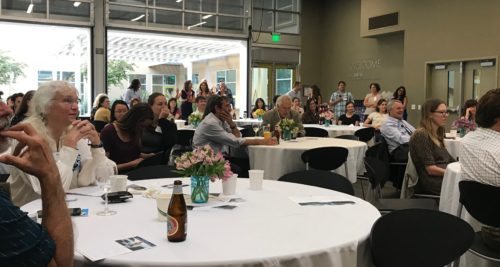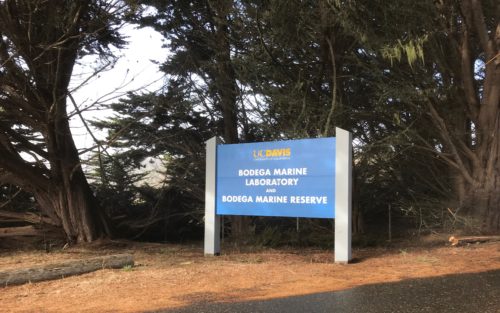Celebration of Susan Williams’ life and impact at UC Davis and Bodega Marine Laboratory
Bill Dennison · 
On 26-27 Oct 2018, friends and colleagues of Susan Williams held a celebration of Susan’s life and impact. The 26 Oct event was held in the International Center on the University of California at Davis campus. Rick Grosberg, UC Davis faculty, served as the emcee. The event was in a beautiful room that opened onto a courtyard with people attending from all facets of Susan’s life. Susan’s sister, Holly Williams, and her brother-in-law, Art Hansen, traveled from their Atlanta home and a friend from the University of Michigan, where Susan did her undergraduate degree, traveled from Seattle. Fred Short and I represented the University of Alaska connection that we had with Susan. Jim Eckman represented Susan’s Stony Brook postdoctoral phase, and there were many people from San Diego State University, University of Washington’s Friday Harbor Laboratory, and the Bodega Marine Laboratory.

The Public Engagement & Policy session was chaired by Jay Stachowicz from UC Davis. The session was kicked off with a wonderful video tribute by Congressman Jared Huffman who worked with Susan on establishing marine sanctuaries off the California Coast. Rep. Huffman entered his testimony about Susan into the Congressional Record.
Ros Naylor from Stanford University spoke about the Aldo Leopold leadership program that she and Susan participated in and the five aspects of leadership that Susan embodied:
- Leading by example, demonstrating personal leadership
- Listening to colleagues, students and community members
- Committing to the ‘long haul’
- Developing and holding trust
- Creating a platform for all to shine.
Christine Sur, who recently took our two-day Integration and Application Course training course when she was a Knauss Fellow, was the first of many former students who talked about how Susan had her official students, but also unofficially mentored many other students (roadside mentees). Christine spoke about how Susan taught her to be “big and brave”.
Frank Mars from Mars, Inc. corporation spoke of Susan’s active participation in the coral reef restoration program in Indonesia that started in 2012. He showed some amazing underwater video of restored coral reefs that Susan helped with. My favorite photo was that of Susan shaking the hand of a little barefoot Indonesian boy who was so proud of having his photo taken with his hero. This restoration program is training local park rangers and Susan took many different graduate students to Indonesia with her.
Dan Howard spoke about the critical role that Susan had in establishing and then advising the local large marine sanctuaries, Greater Farallones National Marine Sanctuary and Cordell Bank National Marine Sanctuary. He spoke of Susan flying to Washington, D.C. to testify on her ‘own dime’ and her regular participation on the advisory committee.
The seagrass and seaweed session was chaired by Megan Dethier, from the University of Washington. Megan read a quote by William James: “We must reflect that, when we reach the end of our days, our life experience will equal what we have paid attention to.” Randall Hughes, a roadside mentee, spoke about Susan’s diverse research portfolio, from “Susie Seagrass” to seaweed research. Susan recruited Randall to our National Center for Ecological Analysis and Synthesis Seagrass Trajectories Working Group when Bob “JJ” Orth and I were looking for students to supplement our group. Randall and her husband, David Kimbro, who had a baby during the NCEAS project, are both at the Nahant Research Laboratory at Northeastern University now. Brent Hughes (no relation to Randall) talked about Susan’s influence on his PhD research at UC Santa Cruz on sea otter, crabs, sea slugs, and seagrass epiphytes trophic cascade. He showed us an aerial photo of a seagrass restoration site in Elkhorn Slough which he has named “Susan’s Garden”. John Bruno spoke about meeting Susan at a party in Malibu when she was talking with Flea, a flamboyant musician in the Red Hot Chili Peppers group. John talked about how Susan was in the second generation of benthic ecologists who did their research underwater, unlike the first generation marine ecologists who conducted their research mostly in the intertidal zone.

The invasive species session was to be chaired by Jim Carlton who was too ill to travel. Matt Bracken stepped in to present Jim’s thorough talk about Susan’s extensive research on invasive species which began with her research on Musculista in San Diego Harbor. The quote used was from Nobel Laureate Albert von Szent-Györgyi: “A discovery is an accident meeting a prepared mind." What was the most impressive about Susan’s 23 papers on marine invasive species was that she was an “invasive species polymath”, touching on invasive species interactions with seagrasses, post-invasion management, invasion vectors and their management, and invasions and climate change.
Cascade Sorte, who was Susan’s PhD student and is now at UC Irvine, talked to many of Susan’s former students and collected words that they used to describe Susan: brilliant, sparkling, incisive, creative, trailblazer, generous, influential, passionate, direct, genuine, diplomatic, frank, tough, human, supportive, impactful, incredible, and honest. This word cloud is an impressive tribute to Susan’s impact on her students. Don Strong from UC Davis spoke about Susan’s productivity and collegiality, even when she served as Director of Bodega Marine Laboratory for ten years.
After these talks about Susan’s science and her impact, we shared some stories about Susan, which included themes like her love of cooking and hosting dinner parties, her flute playing, and her sense of humor. Roberta Marinelli, a former UMCES colleague, spoke of Susan as her “North Star”. I told some stories about our Hydrolab mission (Pigs in Water) in St. Croix which included the pighead and chocolate cake daiquiris, inappropriate seagrass henna tattoos in Santa Barbara, and lending her my crappy car which stranded her on the Long Island Sound ferry. Holly Williams ended the day with a powerful heartfelt and moving speech about her big sister. Holly is a senior officer in the Centers for Disease Control and talks just like Susan with similar facial expressions. I loved meeting Holly and hearing her voice—like Susan, an impressive woman who married well. We had a nice reception and dinner after the session, which was an emotional rollercoaster. We laughed and cried all day long.

The 27 Oct event was held at the Bodega Marine Laboratory (BML) on a gorgeous day. A nice jazz combo was playing in the lobby and we had a nice lunch with views out on the Pacific Ocean. Gary Cherr, the BML Director, hosted the event which include tours of Susan’s office and laboratory (Suzanne Olyarnik kindly took me to visit Susan’s office before the crowd arrived). We told more stories of Susan and were joined by her husband Bruce Nyden. Bruce, Susan, my friend Chuck Gross, and I were the “Pigs in Water” on our Hydrolab mission in 1984, so I have known Bruce since before they were married in 1986. Suzanne Olyarnik was a UC Davis student who participated in the National Center for Ecological Analysis and Synthesis project and she is now the Reserve Director of the Bodega Marine Reserve, part of the University of California Natural Reserve System. Suzanne gave us a walking tour of the property around the Bodega Marine Laboratory and we could see seals frolicking in the Pacific Ocean surf. After the walking tour, I enjoyed sitting with Bruce watching a rotating slide show of Susan photos from her entire life. She really was quite stunning throughout her life.
Bob and Hedy Carpenter from Cal State Northridge were there as well and it was great to see them after many decades. Bob and Hedy were in St. Croix when I was there and we even shared a Stony Brook student. After the BML visit, we were hosted by Bruce Nyden at a funky restaurant in the town of Occidental that featured a steel band, a nice tribute to the Caribbean roots of their relationship. Bruce even danced, which he told me was only the fourth time he has danced in his life. After so much grieving and reflection it was great to cut loose and I left with an enhanced impression of the great people that Susan was able to surround herself with.

In addition to the congressional testimony mentioned earlier, there were some cool tributes to Susan, including a research boat based in San Pedro, California to be named the “Susan Lynn”, her posthumous induction into the Women’s Scientific Diving Hall of Fame, and the seagrass restoration site “Susan’s Garden” in Elkhorn Slough. I suspect there will be more of such tributes and the next Coastal Estuarine Research Federation conference will feature a special session on Susan.
I am grateful to the staff at UC Davis and Bodega Marine Laboratory and to Susan’s family for organizing this wonderful event. I still have a hole in my heart, but it feels less raw and I realize how fortunate I have been to have had Susan in my life for so many years. Her students and younger colleagues have such a reverence and respect for Susan, so I was glad that I could help round out the complete the picture of Susan as an “instigator” with a wicked sense of humor. It was wonderful to catch up with old friends as well. The highest praise that I can share about the event is that Susan would have loved it.
About the author
Bill Dennison

Dr. Bill Dennison is a Professor of Marine Science and Vice President for Science Application at the University of Maryland Center for Environmental Science.

